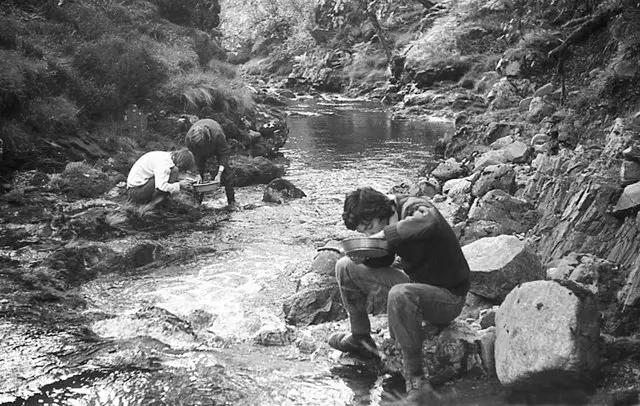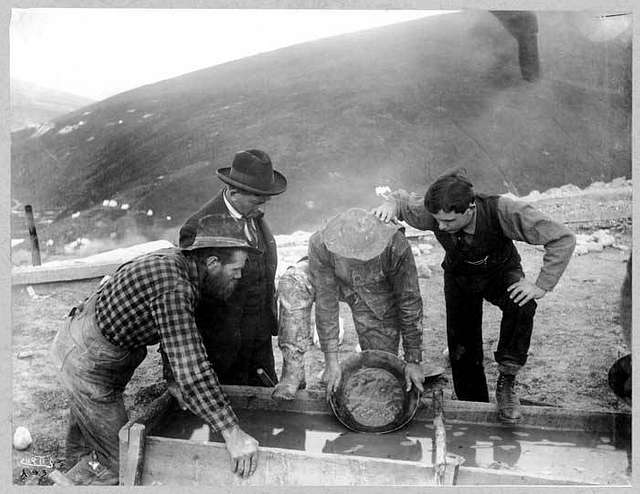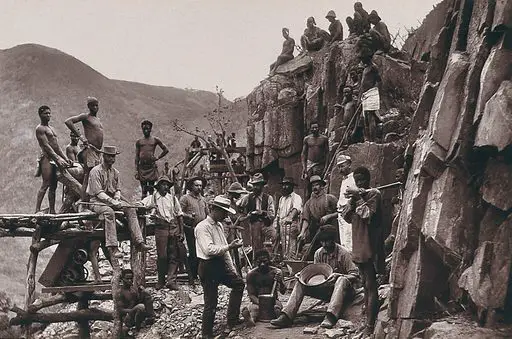Welcome to the enthralling journey through time, where we delve into the remarkable history of Prescott and its economic metamorphosis triggered by the infamous Gold Rush.

The Gold Rush, an event of immense historical significance, has left an indelible mark on the growth and prosperity of Prescott, shaping its destiny in ways that continue to reverberate through the ages.
Early Days of Prescott
Prescott, nestled amidst the rugged terrains of Arizona, was a quaint and humble settlement before the tumultuous arrival of the Gold Rush. In the mid-1800s, it was but a fledgling community, slowly taking root as prospectors and pioneers sought solace in its idyllic landscape.
The economy primarily revolved around small-scale agriculture and limited trading activities. However, everything was about to change with a discovery that would spark the most significant economic boom the region had ever witnessed.
The Gold Rush began with a chance discovery that would alter Prescott’s course forever. In 1863, when gold was found in the region, the news spread like wildfire, attracting thousands of fortune-seekers from all corners of the world. The influx of gold-hungry prospectors turned Prescott into a bustling hub of activity, setting the stage for an unprecedented economic transformation.
Economic Transformation
The Gold Rush acted as a catalyst, propelling Prescott into a period of unparalleled economic prosperity. The newfound gold mines not only attracted prospectors but also gave rise to ancillary industries and services to support the burgeoning population. As mining operations expanded, so did the demand for infrastructure and transportation systems, further fueling economic growth.
The construction of roads, railroads, and bridges became imperative to facilitate the movement of people and goods. The city’s landscape transformed rapidly, adorned with bustling markets, saloons, banks, and hotels catering to the needs of the Gold Rush participants.
Prescott soon emerged as a thriving commercial center, attracting entrepreneurs and businesses eager to capitalize on the burgeoning opportunities.
Population Growth and Demographic Shifts
The allure of gold proved irresistible, drawing individuals from diverse backgrounds and cultures to Prescott. The population soared as immigrants arrived in search of a better life, resulting in a remarkable demographic shift.
A colorful tapestry of people from various regions, speaking different languages, and adhering to diverse traditions, began to weave together the fabric of Prescott’s society.
This influx of people not only enriched the city’s cultural diversity but also contributed significantly to its economic growth. New businesses catering to the needs of the diverse population flourished, creating a vibrant and thriving economy. Prescott became a melting pot of ideas, customs, and traditions, enhancing the city’s unique identity.
The Rise of Small Businesses
As the Gold Rush fever gripped Prescott, entrepreneurs seized the opportunity to capitalize on the surging demand for goods and services. Small businesses sprung up like wildflowers in the valley, catering to the needs of prospectors and settlers alike. General stores, blacksmith shops, restaurants, and hotels thrived as they became vital components of the city’s booming economy.
One such success story was that of John Baxter, who established a thriving mercantile business catering to the needs of miners with high-quality equipment and provisions. His venture not only amassed personal wealth but also contributed significantly to Prescott’s economic growth.

Moreover, banks and financial institutions flourished in the wake of the Gold Rush, providing a secure and stable environment for businesses to flourish. These small enterprises formed the backbone of Prescott’s economy, stimulating further development and expansion in the region.
Social and Cultural Developments
Beyond its economic impact, the Gold Rush shaped the very fabric of Prescott’s society and culture. As prospectors and settlers congregated, communities emerged, bound by the shared pursuit of wealth and opportunity. Social institutions like churches, schools, and civic organizations sprang up, fostering a sense of belonging and camaraderie among the residents.
Prescott’s newfound prosperity attracted talented individuals from various artistic disciplines, leading to a flourishing of arts and literature. Local theaters and art galleries showcased the creativity and talents of the city’s residents, solidifying Prescott’s reputation as a cultural center in the American West.
Challenges and Adversities
Amidst the jubilation of newfound wealth and prosperity, the Gold Rush also brought its fair share of challenges and adversities. The rapid influx of people and mining activities took a toll on the environment. Deforestation, soil erosion, and water pollution were just some of the environmental consequences faced by the city.
Moreover, the labor force that toiled in the gold mines often faced harsh conditions, with little regard for workers’ rights. Unsafe working conditions and meager wages were common grievances voiced by the laborers. These challenges sparked debates on labor laws and regulations, leading to the emergence of labor movements advocating for better working conditions.
Economic Booms and Busts
The Gold Rush’s impact on Prescott’s economy was not without its fluctuations. The cycle of booms and busts characterized the city’s economic trajectory during this period. As gold production peaked, the city experienced unprecedented prosperity, attracting investors and speculators eager to capitalize on the riches.
However, as gold reserves dwindled and production declined, the economy faced downturns, leading to periods of economic instability. Many businesses that had thrived during the boom times found it difficult to sustain their growth during leaner periods, resulting in closures and financial hardships for some.
Nonetheless, these cycles of prosperity and challenges shaped Prescott’s resilience and adaptability, laying the groundwork for a more diverse and sustainable economy in the long run.
Legacy of the Gold Rush
As we fast forward to the present day, the legacy of the Gold Rush remains palpable in Prescott’s landscape and culture. The city has conscientiously preserved its historic landmarks, offering visitors a glimpse into its golden past. Places like the historic Whiskey Row, once home to vibrant saloons and shops, stand as a testament to the bygone era.

Prescott continues to draw tourists and history enthusiasts from across the globe, drawn by the allure of its rich heritage. The preservation of these sites and the celebration of the city’s history contribute to its modern-day economic significance, with tourism becoming an integral part of Prescott’s economic fabric.
Urban Planning and Architecture
Prescott’s urban planning and architecture bear the imprints of its golden heritage. The city’s historic downtown features a blend of architectural styles, reflecting the various phases of its development. From Victorian-era buildings to Territorial-style structures, the city showcases its evolution over time.
Preservation efforts are underway to safeguard these architectural treasures, ensuring that the city’s unique character endures for generations to come. Historic zoning and restoration projects have played a pivotal role in maintaining the charm and allure of Prescott’s architectural heritage.
Economic Diversification
While the Gold Rush may have laid the foundations for Prescott’s economic growth, the city has since diversified its industries to ensure long-term sustainability. Mining, once the backbone of the economy, has gradually given way to a more diverse range of economic activities.
The city’s economic landscape now encompasses sectors such as tourism, healthcare, education, and technology, among others. Tourism has emerged as a significant contributor to Prescott’s economic growth, with visitors from around the world drawn to its rich history, cultural attractions, and scenic beauty.
The healthcare sector has also witnessed significant expansion, with state-of-the-art medical facilities and research centers catering to the needs of residents and attracting patients from neighboring regions. Prescott’s educational institutions, both at the K-12 level and higher education, have garnered a reputation for excellence, producing skilled graduates who contribute to the city’s workforce and economic progress.
Tourism and Heritage
Prescott’s vibrant heritage and historical landmarks continue to be a major draw for tourists, contributing to the city’s economic prosperity. Sites such as the Sharlot Hall Museum offer visitors an immersive experience of the city’s past, while the Phippen Museum celebrates the art and culture of the American West.
The city’s well-preserved downtown, including the iconic Whiskey Row, attracts visitors who enjoy exploring the unique shops, restaurants, and galleries that thrive in these historic settings. In addition to its rich history, Prescott’s natural beauty, including nearby lakes, forests, and hiking trails, offers ample opportunities for outdoor recreation, making it a sought-after destination for nature enthusiasts.
Government Policies and Impact
The role of government policies during the Gold Rush era had a profound impact on shaping Prescott’s economic growth. The establishment of mining laws, property rights, and land ownership regulations played a crucial role in managing the influx of prospectors and ensuring a level playing field for businesses.
Similarly, today’s government policies continue to influence the city’s economic landscape. Prescott’s pro-business environment, coupled with incentives for economic development, has attracted businesses and entrepreneurs, further diversifying the economy and stimulating job creation.
The Gold Rush and Environment
The environmental consequences of the Gold Rush, though significant, have paved the way for greater awareness and sustainable practices in the modern era. Efforts to remediate environmental damage caused by mining activities have been undertaken, restoring natural habitats and ensuring the preservation of local ecosystems.
Prescott’s commitment to sustainability is evident through initiatives such as promoting renewable energy, implementing green building practices, and encouraging responsible water management. The city’s efforts align with global efforts to mitigate climate change and protect the environment for future generations.
Education and Research
Prescott’s rich history continues to be a source of fascination and research for historians, archaeologists, and scholars alike. Academic institutions, such as Prescott College, actively engage in historical research and cultural preservation efforts, contributing to the city’s intellectual and academic environment.
The city’s historical significance also serves as a valuable educational resource for students of all ages. Educational programs and field trips to historic sites provide hands-on learning experiences, enriching students’ understanding of local history and culture.
Infrastructure and Connectivity
Prescott’s modern infrastructure and connectivity are critical factors in its continued economic growth. The city’s strategic location, with access to major highways and transportation networks, facilitates the movement of goods and services, supporting businesses and attracting investors.

Moreover, the city’s commitment to maintaining and upgrading its infrastructure ensures that residents and visitors alike enjoy a high quality of life. Investments in public transportation, recreational facilities, and utilities contribute to Prescott’s appeal as a desirable place to live and work.
Frequently Asked Questions: Impact Of The Gold Rush On Prescott’s Economic Growth
How did the Gold Rush transform Prescott’s economy?
The Gold Rush triggered a significant economic boom in Prescott, attracting thousands of prospectors and settlers, and leading to the development of mining operations, infrastructure, and various industries. It laid the foundation for the city’s economic growth.
What were the major challenges faced during the Gold Rush?
The rapid influx of people resulted in environmental consequences, such as deforestation and water pollution. Additionally, labor issues, including unsafe working conditions and meager wages, were prominent concerns.
What is the lasting impact of the Gold Rush on Prescott’s culture?
The Gold Rush brought together people from diverse backgrounds, contributing to Prescott’s cultural diversity. It also spurred the development of social institutions, arts, and literature, shaping the city’s unique identity.
How did the Gold Rush contribute to the city’s demographic shifts?
The discovery of gold attracted immigrants from various regions, leading to a demographic shift in Prescott. The city became a melting pot of cultures and traditions, enriching its social fabric.
What role did the government play in shaping economic growth during the Gold Rush?
Government policies during the Gold Rush era, such as mining laws and land ownership regulations, influenced the economic landscape. Today, Prescott’s pro-business policies continue to foster economic growth and development.
Summary
The impact of the Gold Rush on Prescott’s economic growth has been profound and enduring. From its humble beginnings as a small settlement, the discovery of gold catapulted Prescott into a thriving commercial center, attracting people from far and wide and shaping its cultural identity.
The legacy of the Gold Rush lives on through the city’s historic landmarks, vibrant arts and culture scene, and diverse economic sectors. Prescott’s ability to adapt and diversify its economy over time has ensured its continued relevance in the modern era.



Leave a Comment
You must be logged in to post a comment.